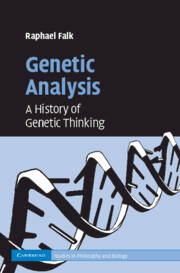Book contents
- Frontmatter
- Contents
- List of figures
- Acknowledgments
- Introduction
- PART I FROM REPRODUCTION AND GENERATION TO HEREDITY
- PART II FAKTOREN IN SEARCH OF MEANING
- PART III THE CHROMOSOME THEORY OF INHERITANCE
- PART IV GENES AS THE ATOMS OF HEREDITY
- PART V INCREASING RESOLVING POWER
- 11 Recruiting bacteria and their viruses
- 12 Molecular “cytogenetics”
- 13 Recombination molecularized
- PART VI DEDUCING GENES FROM TRAITS, INDUCING TRAITS FROM GENES
- PART VII WHAT IS TRUE FOR E. COLI IS NOT TRUE FOR THE ELEPHANT
- Concluding comments
- Bibliography
- Index
12 - Molecular “cytogenetics”
Published online by Cambridge University Press: 07 August 2009
- Frontmatter
- Contents
- List of figures
- Acknowledgments
- Introduction
- PART I FROM REPRODUCTION AND GENERATION TO HEREDITY
- PART II FAKTOREN IN SEARCH OF MEANING
- PART III THE CHROMOSOME THEORY OF INHERITANCE
- PART IV GENES AS THE ATOMS OF HEREDITY
- PART V INCREASING RESOLVING POWER
- 11 Recruiting bacteria and their viruses
- 12 Molecular “cytogenetics”
- 13 Recombination molecularized
- PART VI DEDUCING GENES FROM TRAITS, INDUCING TRAITS FROM GENES
- PART VII WHAT IS TRUE FOR E. COLI IS NOT TRUE FOR THE ELEPHANT
- Concluding comments
- Bibliography
- Index
Summary
Starting with the achievements of microscopists in the 1880s, attention was directed at the cell's nucleus and its chromosomes as the carriers of the genetic material, to the exclusion of the role of the cytoplasm and all its components (the cell membrane was considered inherently irrelevant). Nuclei were composed of nucleo-proteins. Based on the repetitive tetranucleotide structure hypothesis, first proposed by Hermann Steudel in 1906 and developed by Phoebus Levene in 1931 (Deichmann, 2004), the prevailing conception was that nucleic acids comprised stoichiometric aggregates of nucleotide tetrads. Proteins, being the material of enzymes, were celebrated at the first half of the twentieth century as the essence of life. They seemed to be able to provide the diversity that would be expected of the material of heredity thanks to the large number of known amino acids involved in their composition. Toward the end of the 1940s Fred Singer directly demonstrated the diversity of polypeptide chains, and Wendell Stanley's initial erroneous claim in 1935 that crystallized tobacco mosaic virus was a pure self-replicating protein (a study for which Stanley was awarded the 1946 Nobel Prize) further upheld the centrality of proteins in the deliberations on the nature of the hereditary material (see Deichmann, 2004; Lederberg, 1994). These studies were foreign to genetic analysis and its methodology (see Chapter 1).
Two kinds of nucleic acids were conceived, named after their main source at the time, alkali-stable “thymus” nucleic acid, and alkali-labile “yeast” nucleic acid; corresponding to today's DNA and RNA, respectively.
- Type
- Chapter
- Information
- Genetic AnalysisA History of Genetic Thinking, pp. 191 - 201Publisher: Cambridge University PressPrint publication year: 2009



